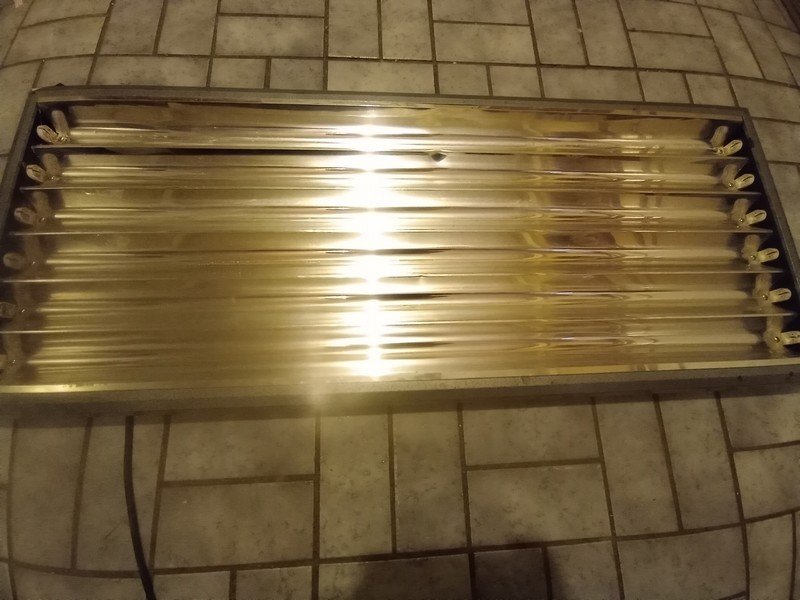Let’s Have A Discussion On Grow Lights

Discussion On Grow Lights
In this blog, I am going to explain the different types of grow lights. The several types that will be discussed are T lights, Metal Halide, High Pressure Sodium, and LEDs. Some of these types of lights need fixtures and ballasts to run the light system. Another type is a complete unit you buy and can switch the bulbs when they go bad, these have ballasts built in to them. The last type is a complete unit that you can not switch bulbs out of at all. All the grow lights I have pictured I purchased over 10 years ago, and they are still running strong, the only thing I have to change are the bulbs. The picture below is a blown Metal Halide bulb, I put that picture on here to show what a blown bulb looks like, being black on both ends.
T 5 Lights
T5 lights come in different lengths and how many bulbs in a fixture. I have 2 examples down below, one T5 is a 2 foot 2 bulbs grow light and the other is a 4ft (ca. 122 cm) in length and a 6 bulb grow light. T5 grow lights are great, especially if you are short on space and are starting plants on a rack. You can place smaller T5 lights under each shelf on a rack system. The other good thing about T5 lights when they are on they give off some heat to help keep your plants warmer, but you want to keep a bit of space between the plant and the light too. These grow lights can range in price from under $100 to a couple of hundred dollars for 1 grow light. The prices vary because of length, how many bulbs, manufactures, and where you buy them from.
Vented Grow Hoods And Ballast
To buy and run this kind of light is costly depending on what set up you want to purchase for the area you are growing in. Some grow shops offer package deals where you can purchase the bulbs, hoods, and ballast from a few hundred dollars and up to $600. A lot depends on what kind of ballast you buy, bulbs and hood styles. Ten years ago Lumatek was the best affordable digital ballast you could buy, it did cost a bit more being a name brand and being a dimmable ballast as well. I liked the dimmable ballast because you could put a 1000 watt bulb in the unit and use the super lumens setting. Which can be used for 600 watts, but you could dim it down to 400 watts with using the same 1000 watt light bulb. These also did well for me in an unfinished non-heated basement, they helped keep the room warm by the amount of heat that these lights generated. The downfalls of these kinds of light is the electric consumption, the cost, and if growing big plants they can burn the plant if they get too close to the light. Also, an added expense in adding a fan and duct work to the side vents if you have heat problems, I was lucky I did not. The upside to these light is they make plants grow taller faster and produce more if blooming plants indoors more watts equals bigger plants.
Bulbs For The Above Grow Lights
.With the T5 and the vented hood ballast set, you can change out bulbs. Like I have pictures below, you can choose different light spectrums to use 2100k high pressure sodium bulb for Blooming and the 5500k Metal Halide bulb was more for vegetative growth. The bulbs I pictured below can range in price depending on the manufacture. Those bulbs were the middle bulb, not the cheapest but not the most expensive and ran about $70 each back in the day. For the T5 they just have 2 light spectrums and normally are inexpensive compared to the higher wattage ones for the vented hoods. The T5 bulbs have price ranges under $50 for 12 bulbs depending on length and where you get them from along with who manufactured the lights.
LED Grow Lights
LED lights are inexpensive to run and lights last a long time. These lights can also be costly to purchase depending on sizes, shapes, lengths, and light power output. LEDs will be sealed units and depending on what kind and how much you paid for the light. If something goes wrong with the unit, most of the time it’s best just to throw it away and get a new one. The ups about LEDs is they barely take any electric to run, and they are working on the spectrums to achieve the growth you get from vented hood and ballast for a fraction of the energy cost. Also, plants can get closer to the lights without getting burned because of how cool LEDs run. But sometimes where you save money it might cost you other ways, like for me, I would have to run a heater because they do not put out much heat.
My Recommendation
My recommendation is that all these grow lights are great and get the job done. I suggest figuring out what uses you are going to be using the grow lights for and do your research to see which type will suit your growing needs the best. There is a picture below to help estimate electric cost by wattage no matter what grow light you use, you can figure out ballpark electric cost. Also, on the chart for T5 and vented grow hoods and ballast, how much light per square foot for growing larger plants. I have to add you get what you pay for, look at grow lights as an investment in your growing needs. As I said in the beginning, the grow lights I purchased are still going strong after being 10-12 years old and only had to replace bulbs.





































